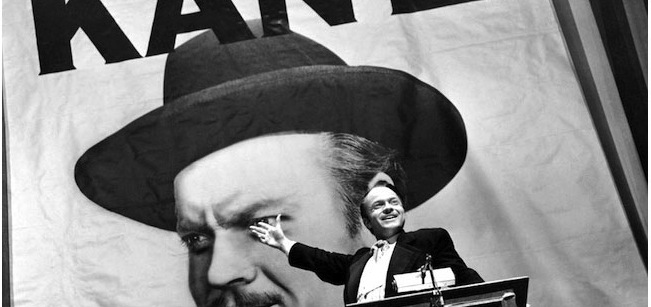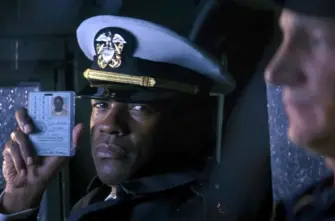Three quarters of a century after its release in 1941, Orson Welles’ towering achievement CITIZEN KANE is still a triumph of style, an endlessly fascinating mystery, a masterpiece to be marveled at for all time. It continually places atop lists of the greatest films of all time, including AFI’s 100 Years… 100 Movies lists, both in 1998 and in 2007.
Welles said, in an undated statement on CITIZEN KANE, “I wished to make a motion picture which was not a narrative of action so much as an examination of character…There have been many motion pictures and novels rigorously obeying the formula of the ‘success story,'” he continued. “I wished to do something quite different. I wished to make a picture which might be called a ‘failure story.'”
While that can certainly be said of the title character — whose rise and fall pivot around that infamous last dying word “rosebud” — the story of CITIZEN KANE is anything but.
In celebration of CITIZEN KANE’s 75th birthday (it was released in theaters on September 5, 1941), here are 15 facts about the groundbreaking film that can perhaps only begin to explain its historic, enduring impact.
1. The initial working draft screenplay of CITIZEN KANE, dated April 16, 1940, was titled “American.”
2. Orson Welles was just 25 years old when he directed, co-wrote, starred in and produced the film, his very first feature.
3. CITIZEN KANE was the feature film debut of Ray Collins, Joseph Cotten, Agnes Moorehead and Everett Sloane — all of whom had worked with Welles on his theater productions or radio broadcasts as members of his Mercury Theatre. It was also the screen debut of Welles himself.
4. Co-screenwriter Herman J. Mankiewicz dictated a majority of the CITIZEN KANE script while bedridden and being cared for by his nurse after shattering his leg in a car crash.
5. Newspaper publisher William Randolph Hearst is the primary inspiration for CITIZEN KANE’s protagonist, Charles Foster Kane. Mankiewicz created Kane’s dialogue using — almost verbatim —lines from Hearst’s own writings and speeches.
6. Hearst was so angered by the film — and in order to keep it from being released — he accused Orson Welles of being a Communist, an accusation that, at the time, had the potential to destroy Hollywood reputations and garner government investigations.
7. The design of Kane’s estate, Xanadu, was inspired by Hearst Castle, Hearst’s extravagant mansion in San Simeon, California. In 2015 – 74 years after its release – CITIZEN KANE screened at Heart Castle for the very first time. Tickets for this benefit screening, which consisted of 60 attendees, cost $1,000 each.
8. CITIZEN KANE was nominated for nine Academy Awards®, but won only one: Best Screenplay. Co-writers Welles and Mankiewicz shared the award.
9. Welles viewed John Ford’s film STAGECOACH about 40 times over the course of one month while making the film, modeling shots from the director’s techniques. Nominated for CITIZEN KANE, Welles would end up losing out on the Best Picture Oscar® to Ford’s HOW GREEN WAS MY VALLEY held in 1942.
10. While filming a scene in which his character violently trashes a room, Welles was so immersed in his character that he cut both of his hands, causing them to bleed. Commenting on his dramatic commitment afterward, he said, “I really felt it.”
11. Welles, along with cinematographer Gregg Toland, popularized and perfected the technique of “deep focus,” keeping every object in the foreground, center and background in simultaneous focus. One example of this is during the scene inside Mrs. Kane’s house, where young Kane can clearly be scene throwing snowballs at the house in the distance while the audience is privy to the mother’s conversation inside.
12. On the ninth take of the sled-burning scene, the furnace had grown so hot, the flue caught fire, which caused the Culver City Fire Department to respond to the location. Welles was noted to be delighted with the commotion.
13. While filming a dramatic sequence in which Kane chases his rival down a flight of stairs, Welles tripped and fell about 10 feet, suffering a chipped ankle. The injury forced him to direct from a wheelchair for two weeks.
14. The opening scene, in which a dying Kane whispers the pivotal line of “Rosebud,” was shot in one take. It was the final scene shot during production. “Rosebud” ranks at #17 on AFI’s 100 top film quotes of all time.
15. In 1975, 34 years after the release of CITIZEN KANE, Welles was honored with the 3rd AFI Life Achievement Award. He was the first actor/director to receive the award. Watch his full acceptance speech below.













melissa Mcentyre
It still is one of the all time greats. It is always fun to see facts list about loved films
LLL
As Hearst was so extremely angered with the film, I am surprised the Castle screened the film. Would that not have angered William Randolph Hearst? Who benefited from the screening? I am also surprised there were only 60 attendees at the screening of the film.
Tim
I’m also very surprised to read that the castle aired the film – Hearst would have DETESTED the idea! But I guess the historic connection and marketing potential for an event like this calls for it.
Sherman Goodrich
While the magnitude of the movie is beyond question.
I still find it interesting that the entire premise revolves around “Rosebud”, his highly publicized dying last word that was uttered in an empty room for no one to hear.
The nurse entered the room after his death.
Andrée
To Sherman Goodrich –
Yes quite. The butler also says he hears the dying word yet we don’t meet him until almost the end of the movie. It is still a wonderful film, though.
Tim
I have a feeling Welles was more interested in the dramatic effect of the scene – I tend to suspend my disbelief and just know that somehow people know “Rosebud” was his dying word. Like the other guy said, we don’t see the full room so the butler could well have been there.
Alex Krajci
1941’s Citizen Kane Is My Favorite Film Of All Time.
Michael Ahlgren
One could speculate the nurse heard both’Rosebud’, and the snow globe fall to the floor which is why she rushed into the room.
Alexander Chrestopoulos
We also never see the entire room in any shot so hypothetically the butler could have been in the room the entire time.
Robert Rousseau
Part of what angered Hearst was that ‘Rosebud’ was his nickname for Marion Davies.
Alexander Chrestopoulos
Actually, it was the nickname for her clitoris which is the biggest reason Hearst was so incensed. Not to mention it’s the first spoken dialogue in the movie.
kevin spacey
It’s amazing. Fantastic information is shared about CITIZEN KANE.
Alex Krajci
Top 10:
1. Citizen Kane (1941)
2. The Dark Knight (2008)
3. Raiders Of The Lost Ark (1981)
4. The Godfather (1972)
5. Schindler’s List (1993)
6. The Birth Of A Nation (1915)
7. Pulp Fiction (1994)
8. Do The Right Thing (1989)
9. King Kong (1933)
10. Fantasia (1940)
Alex Krajci
Top 10:
1. Citizen Kane (1941)
2. The Dark Knight (2008)
3. Raiders Of The Lost Ark (1981)
4. The Godfather (1972)
5. Schindler’s List (1993)
6. The Birth Of A Nation (1915)
7. Pulp Fiction (1994)
8. Do The Right Thing (1989)
9. King Kong (1933)
10. Fantasia (1940)
Dirkesauce
Mank brought me here
Tim
I found Mank to be a huge disappointment – an utter bore. However, a beautiful ‘looking’ film, really pays homage to the visual style of the films of the time. But the story was aimless with really zero exploration of character. If you want to experience Kane from other angles, obviously first watch Citizen Kane, but also watch ‘RKO 281’, and ‘The Cats Meow’